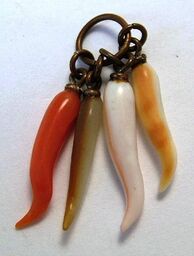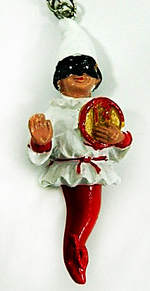 The cimaruta is a very old Italian portafortuna (good luck charm) rooted in the lore of the ancient Pagan religions of Italy. It can be worn around the neck or hung above an infant's bed to ward off any evil. Like many of the lasting ancient symbols and beliefs, the cimaruta design eventually took on certain symbols of Catholicism. One example of a Christian addition to the design is the appearance of "the sacred heart" of Jesus. However, ancient Roman charms did include a heart symbol, which may indicate that the heart on the cimaruta isn't an entirely new addition. The traditional cimaruta is fashioned after the leafy sprig of rue, which is an herb that is highly featured in Italian magic and lore. The branch of the rue is divided into three stems symbolizing the three forms of the goddess Diana. Rue was a sacred herb for Diana. Various charms appear on the rue design, each having its own meaning. The main symbols are the moon, serpent, and key. These represent the goddess as Hecate (the key), Diana (the moon) and Proserpina (the serpent). There may also be a rose; a hand holding either a wand or a sword; a flaming heart; a fish or dolphin (a nod to Diana); an owl (to flirt with the Devil); a plumed medieval helmet; a vervain blossom (a flower from Italian fairy ore); a cherub; a rooster (watchful guardian); and an eagle (able to see evil coming from far away). One cimaruta, for example, might bear the collective imagery of a key, dagger, blossom and moon. The cimaruta is worn nowadays more by women than men.  Mano in Fica The clenched fist with a trusting thumb is known as mano in fica or simply, mano figa ("fig-hand"), or far le fiche ("c*nt gesture", pardon the profanity), for the resemblance to female genitalia. The word figa itself is a very vulgar word to describe a vagina in Italy. Such a rude hand gesture was common in past centuries, similar to "giving the finger" or "flipping the bird", but has fallen out of use. Dante's Divine Comedy (Inferno, Canto XXV) mentions the mano in fica. Supposedly, this charm is used to insult the devil and others casting evil spells.  Cornetto The cornetto, shaped like a horn or chili pepper, is still popular in Southern Italy around Naples, Calabria and in the rest of Mezzogiorno (southern Italy). In Calabria and Naples this charm is worn as jewelry, hung on rear view mirrors, hung in shop windows, on key rings, and on t-shirts. It is more effective if it is red (representing an enemy's blood) and topped with a crown (representing wealth). The cornetto is a symbol of virility (obvious with its phallic shape), but it also brings luck, wealth, success and can also used by women. A similar magical horn of plenty was carried by the Roman Goddess Abundantia to represent abundance, and many think the cornetto has its roots in ancient Roman times.  Mano Corno An alternative to the cornetto, some claim the Mano Corno can ward off the malocchio (evil eye). However, in Italy, the Mano Corno can be seen as offensive... this hand gesture is called cornuto, or a cuckolded man. Give this hand sign to an Italian man and you are basically calling him weak, pathetic and unmanly. This sign--along with sticking up a middle finger--are the most insulting signs you can insult an Italian man with. This charm directly insults the devils and his demons himself.  Coccinella The Coccinella, or ladybug (ladybird) charm brings luck in the arena of love and romance. it's a very common charm in Italy, especially with women. The red color has multiple meanings... red represents victory over one's enemies (spilling their blood); red helps ward off malocchio; and red also is the color of passion and romance. Another fact about the ladybug is they eat the bad bugs who would eat a farmer's crops, so of course they came to be thought of as a sign of good luck, helping prevent crop failure.
|
On AMAZON:
|









 RSS Feed
RSS Feed

